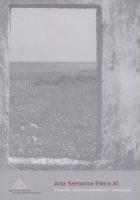Jutustajakujudest Karl Ristikivi „Põlevas lipus”
Narrator figures in The Burning Flag by Karl Ristikivi
Author(s): Eva LepikSubject(s): Theoretical Linguistics, Studies of Literature, Estonian Literature
Published by: Eesti Semiootika Selts
Keywords: Karl Ristikivi; The Burning Flag; narratology; narrator; heterodiegetic we-narrating;
Summary/Abstract: The article examines the level of narration in Karl Ristikivi’s novel The Burning Flag (“Põlev lipp”) and the various narrators inhabiting this level together with their addressees and narrative strategies. The close reading of the novel reveals that the narration functions in four different regimes (neutral, documentary chronicle, the writer, the narrator – and the latter two combined). The narrators that can be detected also have as their counterparts clearly defined addressees – the writer has the “learned reader” and the narrator has the listeners around the campfire. The mode of we-narrative entails both of the narrators. The distance of the narrators in respect of the story is different – the narrator presents the story from the viewpoint of the witness whereas the writer admits his reliance on written sources. The we-narrator combines these two perspectives and this results in a metaphysical viewpoint on the human being and history also present in Ristikivi’s earlier novels (especially in the dilogy All that ever was and Nothing happened). It is rather remarkable that the novel reveals as the addressee of the we-narrator the ideal reader of the novel.
Journal: Acta Semiotica Estica
- Issue Year: 2014
- Issue No: 11
- Page Range: 208-230
- Page Count: 23
- Language: Estonian

